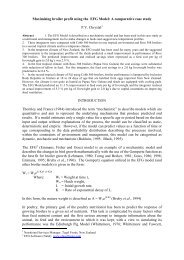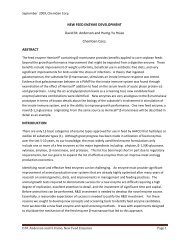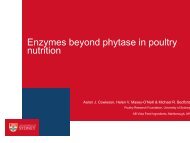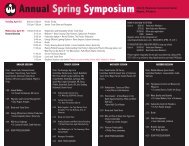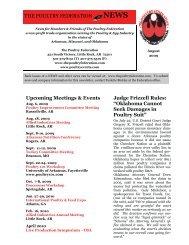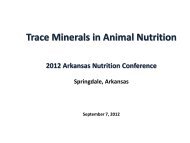Phosphorus Requirements for Broiler Breeder Hens - The Poultry ...
Phosphorus Requirements for Broiler Breeder Hens - The Poultry ...
Phosphorus Requirements for Broiler Breeder Hens - The Poultry ...
Create successful ePaper yourself
Turn your PDF publications into a flip-book with our unique Google optimized e-Paper software.
eeders from each non-colostomized group and ten colostomized breeders theexperimental diets with added acid insoluble ash (Celite). Data from this experiment weresubjected to “two group t- test” to determine the statistical significance (SAS Institute,1999).Although the P excretion difference was not significant (P=0.15) during the six weekbreeder study, a numerical improvement of 2.09 percentage points P retention and 3.69percentage points Ca retention was obtained <strong>for</strong> non-colostomized breeders fed largersize limestone particles compared to non-colostomized breeders fed smaller particle sizelimestone (Table 9). <strong>The</strong>re was a significant (P < 0.0001) improvement of 3.22percentage points in tibia ash content in the group fed larger particle size limestonecompared to hens fed smaller particle size limestone <strong>for</strong> a 6 wk (Table 9) period. Averagehen day egg production <strong>for</strong> a period of 6 wk showed no difference (P > 0.05) between thetwo groups of broiler breeder hens fed two different particle sizes of limestone (Table 9).For the non-colostomized birds, feeding a larger particle size of limestone significantly (P< 0.05) increased the specific gravity of eggs as compared to smaller particle sizelimestone fed group (Table 9). A numerical improvement of 0.12 percentage points in %dry shell weight and 0.59 mg/cm 2 in shell weight per unit surface area (SWUSA) wereobtained <strong>for</strong> non-colostomized breeders fed larger size limestone particles compared tonon-colostomized breeders fed smaller particle size limestone (Table 9). <strong>The</strong> diurnalpatterns of total urinary Ca and P excretion by broiler breeder hens are shown in theFigure 12. <strong>The</strong> total P excretion was low during 0-11 h, and 20-24 h post oviposition,whereas the P excretion was at its maximum during 11-20 h post oviposition. <strong>The</strong> total




